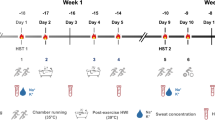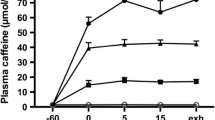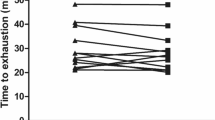Abstract
Purpose
The aim of this study was to establish a model to estimate the level of arterial oxygen saturation (SpO2) and help determine the appropriate hypoxic dose in humans exercising in acute hypoxia.
Methods
SpO2 values were collected in seven untrained (UTS) and seven endurance-trained male subjects (ETS) who performed six cycle incremental and maximal tests at sea level and at simulated altitudes of 1000, 1500, 2500, 3500 and 4500 m. Oxygen uptake was continuously measured and maximal oxygen uptake (\(\dot{\mathrm{V}}{\mathrm{O}}_{2\mathrm{max}}\)) was determined in each subject and at each altitude. Intensity was expressed as percentage of \(\dot{\mathrm{V}}{\mathrm{O}}_{2\mathrm{max}}\).
Results
There were strong non-linear relationships between altitude and SpO2 at low, moderate and high intensity both in ETS and UTS (r = 0.97, p < 0.001). SpO2 was significantly correlated to exercise intensity at sea level and at all simulated altitudes in ETS but only from 2500 m in UTS. There were inverse correlations between SpO2 and sea-level \(\dot{\mathrm{V}}{\mathrm{O}}_{2\mathrm{max}}\) at all altitudes, which were stronger from 2500 m and with the increase in exercise intensity. The three-variable model we established predicts (p < 0.001) the SpO2 level of individuals exercising in acute hypoxia based on their sea-level \(\dot{\mathrm{V}}{\mathrm{O}}_{2\mathrm{max}}\), the intensity of exercise and the altitude level.
Conclusion
The model demonstrates that the drop of SpO2 during exercise in acute hypoxia is larger with the increase in both sea-level \(\dot{\mathrm{V}}{\mathrm{O}}_{2\mathrm{max}}\) and exercise intensity. The model also highlights that the pivotal altitude from which the fall in SpO2 is exacerbated is between 2000 and 2500 m, depending on both sea-level \(\dot{\mathrm{V}}{\mathrm{O}}_{2\mathrm{max}}\) and exercise intensity.





Similar content being viewed by others
Abbreviations
- \({{\text{C}{\bar{\text{v}}}\text{O}}}_{{2}}\) :
-
Venous oxygen concentration
- ETS:
-
Endurance-trained subjects
- FIO2 :
-
Inspired oxygen fraction
- LLTH:
-
Living low training high
- O2 :
-
Oxygen
- PO2 :
-
Oxygen partial pressure
- SaO2 :
-
Arterial oxygen saturation
- SpO2 :
-
Transcutaneous arterial oxygen saturation
- UTS:
-
Untrained subjects
- \({{\dot{\mathrm{V}}\mathrm{A}/\dot{\mathrm{Q}}}}\) :
-
Ventilation-to-perfusion ratio
- \({\dot{\mathrm{V}}\mathrm{O}}_{{2}}\) :
-
Oxygen uptake
- \({\dot{\mathrm{V}}\mathrm{O}}_{{{\mathrm{2max}}}}\) :
-
Maximal oxygen uptake
- \({\dot{\mathrm{V}}\mathrm{O}}_{{{\mathrm{2max}}}} {\mathrm{SL}}\) :
-
Sea-level maximal oxygen uptake
References
Anchisi S, Moia C, Ferretti G (2001) Oxygen delivery and oxygen return in humans exercising in acute normobaric hypoxia. Pflugers Arch 442:443–450
Barker SJ (2002) “Motion-resistant” pulse oximetry: a comparison of new and old models. Anesth Analg 95:967–972
Calbet JA, Lundby C (2009) Air to muscle O2 delivery during exercise at altitude. High Alt Med Biol 10:123–134
Connett RJ, Honig CR, Gayeski TE, Brooks GA (1990) Defining hypoxia: a systems view of VO2, glycolysis, energetics, and intracellular PO2. J Appl Physiol 68:833–842
Dempsey JA, Wagner PD (1999) Exercise-induced arterial hypoxemia. J Appl Physiol 87:1997–2006
Dempsey JA, Hanson PG, Henderson KS (1984) Exercise-induced arterial hypoxaemia in healthy human subjects at sea level. J Physiol 355:161–175
Faiss R, Pialoux V, Sartori C, Faes C, Deriaz O, Millet GP (2013) Ventilation, oxidative stress, and nitric oxide in hypobaric versus normobaric hypoxia. Med Sci Sports Exerc 45:253–260
Ferretti G, Moia C, Thomet JM, Kayser B (1997) The decrease of maximal oxygen consumption during hypoxia in man: a mirror image of the oxygen equilibrium curve. J Physiol 498:231–237
Fukuda T, Maegawa T, Matsumoto A, Komatsu Y, Nakajima T, Nagai R, Kawahara T (2010) Effects of acute hypoxia at moderate altitude on stroke volume and cardiac output during exercise. Int Heart J 51:170–175
Galy O, Le Gallais D, Hue O, Boussana A, Préfaut C (2005) Is exercise-induced arterial hypoxemia in triathletes dependent on exercise modality ? Int J Sports Med 26:719–726
Gavin T, Stager MJ (1999) The effect of exercise modality on exercise-induced hypoxemia. Respir Physiol 115:317–323
Ghofrani HA, Reichenberger F, Kohstall MG, Mrosek EH, Seeger T, Olschewski H, Seeger W, Grimminger F (2004) Sildenafil increased exercise capacity during hypoxia at low altitudes and at Mount Everest base camp: a randomized, double-blind, placebo-controlled crossover trial. Ann Intern Med 141:169–177
Hammond MD, Gale GE, Kapitan KS, Ries A, Wagner PD (1986) Pulmonary gas exchange in humans during exercise at sea level. J Appl Physiol 60:1590–1598
Hippisley-Cox J, Coupland C, Vinogradova Y, Robson J, May M, Brindle P (2007) Derivation and validation of QRISK, a new cardiovascular disease risk score for the United Kingdom: prospective open cohort study. BMJ 335:136
Hopkins SR (2006) Exercise induced arterial hypoxemia: the role of ventilation-perfusion inequality and pulmonary diffusion limitation. Adv Exp Med Biol 588:17–30
Kenney WL, Wilmore J, Costill DL (2015) Physiology of sport and exercise, 6th edn. Human Kinetics, Champaign, IL
Laursen PB, Rhodes EC, Langill RH, Taunton JE, McKenzie DC (2005) Exercise-induced arterial hypoxemia is not different during cycling and running in triathletes. Scand J Med Sci Sports 15:113–117
Martin D, O’Kroy J (1993) Effects of acute hypoxia on the VO2max of trained and untrained subjects. J Sports Sci 11:37–42
Mollard P, Woorons X, Letournel M, Cornolo J, Lamberto C, Beaudry M, Richalet JP (2007a) Role of maximal heart rate and arterial O2 saturation on the decrement of VO2max in moderate acute hypoxia in trained and untrained men. Int J Sports Med 28:186–192
Mollard P, Woorons X, Letournel M, Lamberto C, Favret F, Pichon A, Beaudry M, Richalet JP (2007b) Determinants of maximal oxygen uptake in moderate acute hypoxia in endurance athletes. Eur J Appl Physiol 100:663–673
Mollard P, Bourdillon N, Letournel M, Herman H, Gibert S, Pichon A, Woorons X, Richalet JP (2010) Validity of arterialized earlobe blood gases at rest and exercise in normoxia and hypoxia. Respir Physiol Neurobiol 172:179–183
Ortiz-Prado E, Dunn JF, Vasconez J, Castillo D, Viscor G (2019) Partial pressure of oxygen in the human body: a general review. Am J Blood Res 9:1–14
Peltonen JE, Tikkanen HO, Rusko HK (2001) Cardiorespiratory responses to exercise in acute hypoxia, hyperoxia and normoxia. Eur J Appl Physiol 85:82–88
Piiper J, Scheid P (1981) Model for capillary-alveolar equilibration with special reference to O2 uptake in hypoxia. Respir Physiol 46:193–208
Powers SK, Dodd S, Lawler J, Landry G, Kirtley M, McKnight T, Grinton S (1988) Incidence of exercise induced hypoxemia in elite endurance athletes at sea level. Eur J Appl Physiol Occup Physiol 58:298–302
Prommer N, Sottas PE, Schoch C, Schumacher YO, Schmidt W (2008) Total haemoglobin mass: a new parameter to detect blood doping? Med Sci Sports Exerc 40:2112–2118
Rice AJ, Scroop GC, Thornton AT, Mc Naughton NS, Rogers KJ, Chapman MJ, Greville HW, Scicchitano R, Gore CJ (2000) Arterial hypoxemia in endurance athletes is greater during running than cycling. Respir Physiol 123:235–246
Richalet JP, Herry JP (2016). Médecine de montagne, 5ème ed. Elsevier-Masson ed., Paris, France
Saltin B (1969) Physiological effects of physical conditioning. Med Sci Sports Exerc 1:50
Savourey G, Launay JC, Besnard Y, Guinet-Lebreton A, Alonso A, Sauvet F, Bourrilhon C (2007) Normo or hypobaric hypoxic tests: propositions for the determination of the individual susceptibility to altitude illnesses. Eur J Appl Physiol 100:193–205
Schmutz S, Däpp C, Wittwer M, Durieux AC, Mueller M, Weinstein F, Vogt M, Hoppeler H, Flück M (2010) A hypoxia complement differentiates the muscle response to endurance exercise. Exp Physiol 95:723–735
Soo J, Girard O, Ihsan M, Fairchild T (2020) The use of the SpO2 to FiO2 ratio to individualize the hypoxic dose in sport science, exercise, and health Settings. Front Physiol 11:570472
Sutton JR, Reeves JT, Wagner PD, Groves BM, Cymerman A, Malconian MK, Rock PB, Young PM, Walter SD, Houston CS (1988) Operation Everest II: oxygen transport during exercise at extreme simulated altitude. J Appl Physiol 64:1309–1321
Torre-Bueno JR, Wagner PD, Saltzman HA, Gale GE, Moon RE (1985) Diffusion limitation in normal humans during exercise at sea level and simulated altitude. J Appl Physiol 58:989–995
Trivedi NS, Ghouri AF, Lai E, Shah NK, Barker SJ (1997) Pulse oximeter performance during desaturation and resaturation: a comparison of seven models. J Clin Anesth 9:184–188
Van Thienen R, Hespel P (2016) Enhanced muscular oxygen extraction in athletes exaggerates hypoxemia during exercise in hypoxia. J Appl Physiol 120:351–361
Wagner PD, Gale GE, Moon RE, Torre-Bueno JR, Stolp BW, Saltzman A (1986) Pulmonary gas exchange in humans exercising at sea level and simulated altitude. J Appl Physiol 61:260–270
West JB (1997) Pathophysiology, 5th edn. Lippincott Williams & Wilkins, Philadelphia, PA
Woorons X, Mollard P, Lamberto C, Letournel M, Richalet JP (2005) Effects of acute hypoxia on maximal exercise in trained and sedentary women. Med Sci Sports Exerc 37:147–154
Woorons X, Mollard P, Pichon A, Lamberto C, Duvallet A, Richalet JP (2007) Moderate exercise in hypoxia induces a greater arterial desaturation in trained than untrained men. Scand J Med Sci Sports 17:431–436
Acknowledgements
The authors express their gratitude to all the participants for their great commitment
Funding
The authors declare that they received no funding for this work.
Author information
Authors and Affiliations
Contributions
XW and JPR conceived and designed research, conducted the experiments and interpreted the results. XW wrote the manuscript. All authors have reviewed and approved the manuscript prior to submission.
Corresponding author
Ethics declarations
Conflict of interest
The authors declare that they have no conflict of interest and have not received any funding for this work.
Additional information
Communicated by I. Mark Olfert.
Publisher's Note
Springer Nature remains neutral with regard to jurisdictional claims in published maps and institutional affiliations.
Rights and permissions
About this article
Cite this article
Woorons, X., Richalet, J.P. Modelling the relationships between arterial oxygen saturation, exercise intensity and the level of aerobic performance in acute hypoxia. Eur J Appl Physiol 121, 1993–2003 (2021). https://doi.org/10.1007/s00421-021-04667-8
Received:
Accepted:
Published:
Issue Date:
DOI: https://doi.org/10.1007/s00421-021-04667-8




